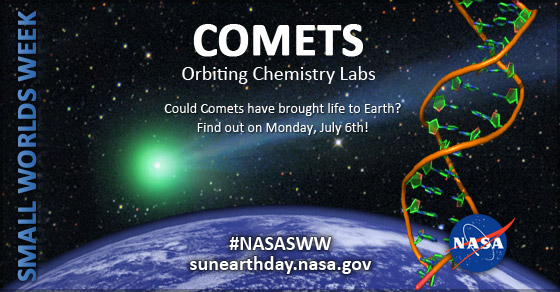
Join the discussion with NASA planetary scientists during Small Worlds Week, July 6-10!
Comets may contain the oldest material in the solar system and may hold the secrets to how the solar system formed. Long feared as the forbearers of doom, comets may in fact have played an important role in seeding life here on Earth by providing both water and amino acids to a barren planet over 4 billion years ago. NASA, JAXA, and ESA space missions such as ISEE-3/ICE, Sakigake, Giotto, Stardust, Deep Impact, and the recent Rosetta/Philae are trying to find out.

Claudia J. Alexander, Ph.D., is a research scientist specializing in geophysics and planetary science. At the Jet Propulsion Laboratory, she was the last project manager of NASA's Galileo mission to Jupiter and is currently the Project Scientist of NASA's contribution to the European-led Rosetta mission to comet 67P/Churyumov-Gerasimenko.
Alexander wanted to be a journalist, but her parents-who were paying for her education-wanted her to become an engineer. After a summer job at NASA's Ames Research Center, in Palo Alto, CA, she became interested in planetary science. She earned her Ph.D. in the physics of space plasma from the University of Michigan in 1993 -where she was named Woman of the Year.
Alexander has worked as a researcher on diverse topics, including: the evolution and interior physics of comets, Jupiter and its moons, magnetospheres, plate tectonics, space plasma, the discontinuities and expansion of solar wind, and the planet Venus. She has written or co-authored 21 papers, and made a substantial contribution to the science-learning Windows to the Universe website.
Alexander has received many awards and has appeared on numerous Discovery Channel, History Channel, and NOVA programs.

Karl Battams is an astrophysicist and computational scientist based at the Naval Research Laboratory (NRL) in Washington DC. He has operated the NASA-funded Sungrazing Comets Project since 2003, overseeing the majority of the project's near-3000 comet discoveries. In 2012-2013, Karl was a member of NASA's CIOC team that oversaw the unprecedented global observing campaigns for Comet ISON and Comet Siding Spring. In addition to his comet work, Karl performs data analysis and visualizations for various ongoing solar physics projects within the NRL Space Science Division, primarily with data recorded by the SOHO and STEREO satellites. He has a strong interest in the growing field of "Big Solar Data" and addressing the challenge of getting the most out of the enormous quantities of solar physics data now being amassed.
Karl is enthusiastic about public outreach and presentation of science. He holds a monthly public Q&A and the Smithsonian National Air and Space museum in DC, and visits local schools to talk about comets and astronomy. He has given numerous public talks on the subject both nationally and internationally, as well as countless media interviews, and several television documentary appearances. He tweets frequently from his @SungrazerComets Twitter account.
Outside of astronomical work, Karl can usually be found either on or close to water, with a passion for kayaking, fishing and hiking.

Research Background:
Dr. George Clark graduated from the joint Ph.D. program between University of Texas at San Antonio and Southwest Research Institute. His Ph.D. work was primary focused on plasma instrumentation for the Juno mission to Jupiter and charged particle transport dynamics in Saturn's magnetosphere. After graduation he joined NASA's Heliophysics Science Division, where he is currently working on Rosetta's Ion and Electron Sensor (IES). Dr. Clark is primarily interested in the dynamics of charged dust around comet 67P/Churyumov-Gerasimenko. As the comet approaches the Sun the nucleus warms and produces an expanding atmosphere through sublimation of volatile elements (primarily water). Dust can be trapped in this expanding atmosphere and subsequently charged by the local plasma environment. The spatial distribution of charged dust and its effects within the plasma have important physical implications.
Personal Background:
George and his wife Chelsea have an eight-month old son, which is their focus outside of work. They enjoy putting Grayson into the jogger or backpack and going for hikes around Maryland. George also likes taking Grayson to museums, especially the Air and Space museum, and introducing him to all the exhibits. The Cessna cockpit is probably Grayson's favorite. George's other interests include hockey, running, cooking, observing the night sky, and eating pastries.

Dr. Mark Hofstadter is a Planetary Scientist working at NASA's Jet Propulsion Laboratory in Pasadena, California. His research focuses on the giant planets in our solar system (Jupiter, Saturn, Uranus, and Neptune), and comets. Dr. Hofstadter uses both ground- and space-based radio telescopes in the course of his work. Currently, most of his efforts are focused on a small radio telescope called MIRO (which stands for Microwave Instrument for the Rosetta Orbiter), on board the European's Rosetta spacecraft. Right now, MIRO is flying along side a comet. He also works with the Goldstone-Apple Valley Radio Telescope (GAVRT) program. GAVRT is a partnership between scientists and educators that allows middle- and high-school students to carry out real scientific research as part of their math and science classes. When not at work, he enjoys playing beach volleyball and watching the waves.
During a single second, the sun converts 4 million tons of matter into pure energy.